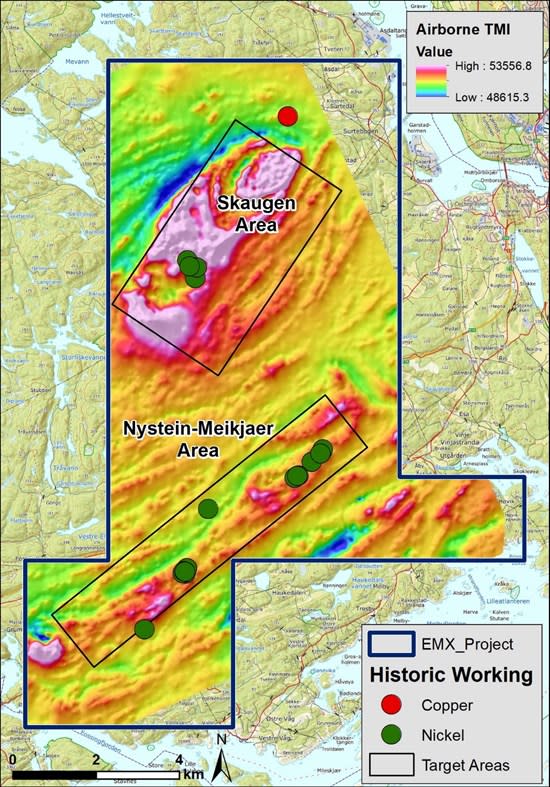Ottawa, Ontario–(Newsfile Corp. – July 26, 2023) – Gold79 Mines Ltd. (TSXV: AUU) (OTCQB: AUSVF) (“Gold79” or the “Company”) is pleased to announce the closing of a second final tranche of its non-brokered private placement financing, raising gross proceeds of $249,314 through the issuance of 8,310,457 units at $0.03 per unit. In total, including the first tranche of the placement, 15,310,457 units were issued for gross proceeds of $459,314.
Each unit consists of one common share of the Company and one whole common share purchase warrant. A total of 8,310,457 warrants were issued in the second tranche, with each warrant entitling the holder to purchase one common share of the Company at a price of $0.05 per share until July 26, 2025. The warrants are callable after the statutory hold period, at the option of the Company, in the event that the 20-day volume-weighted average price of the Company’s common share meets or exceeds $0.08 for ten consecutive trading days based on trades on the TSX Venture Exchange (“TSX-V”) and Alternative Trading Systems. Subscribers will be notified of the call provision being triggered and will have a 30-day period to exercise the warrants.
In connection with the second tranche of the placement a cash finder fee of $210 was paid and 7,000 finder warrants were issued. The finder warrants are exercisable at $0.05 per share and expire on July 26, 2025.
This private placement is subject to the final approval of the TSX-V. All securities issued in the first tranche of the placement are subject to a statutory hold period until October 9, 2023 and for the second tranche until November 27, 2023, respectively.
It is anticipated that approximately 50 percent of the aggregate proceeds raised under the offering will be used for exploration expenditures, land management costs and property payments; approximately 25 percent will be used to pay management fees to Company officers; and, approximately 25 percent will be used for working capital and general corporate purposes.
The securities issued in the private placement will not be registered under the United States Securities Act of 1933, as amended (the “U.S. Securities Act”) and may not be offered or sold within the United States or to or for the account or benefit of U.S. persons, except in certain transactions exempt from the registration requirements of the U.S. Securities Act. This press release does not constitute an offer to sell, or the solicitation of an offer to buy, securities of the Company in the United States.
Gold Chain annual property payment
The Company intends to issue 2,062,548 common shares of the Company in connection with a US$48,000 ($63,283) share payment due under the option agreement covering a portion of the Company’s landholdings for the Gold Chain project in Arizona. The common shares issued will have a statutory hold period of four months and one day from the date of issuance. This shares for debt transaction remains subject to TSX-V approval.
About Gold79 Mines Ltd.
Gold79 Mines Ltd. is a TSX Venture listed company focused on building ounces in the Southwest USA. Gold79 holds 100% earn-in option to purchase agreements on three gold projects: the Jefferson Canyon Gold Project and the Tip Top Gold Project both located in Nevada, USA, and, the Gold Chain Project located in Arizona, USA. In addition, Gold79 holds a 32.3% interest in the Greyhound Project, Nunavut, Canada under JV by Agnico Eagle Mines Limited.
For further information regarding this press release contact:
Derek Macpherson, President & CEO
Phone: 416-294-6713
Email: dm@gold79mines.com
Website: www.gold79mines.com.
Book a 30-minute meeting with our CEO here.
Stay Connected with Us:
Twitter: @Gold79Mines
Facebook: https://www.facebook.com/Gold79Mines
LinkedIn: https://www.linkedin.com/company/gold79-mines-ltd/
FORWARD-LOOKING STATEMENTS:
This press release may contain forward-looking statements that are made as of the date hereof and are based on current expectations, forecasts and assumptions which involve risks and uncertainties associated with our business including the uncertainty as to whether further exploration will result in the target(s) being delineated as a mineral resource, capital expenditures, operating costs, mineral resources, recovery rates, grades and prices, estimated goals, expansion and growth of the business and operations, plans and references to the Company’s future successes with its business and the economic environment in which the business operates. All such statements are made pursuant to the ‘safe harbour’ provisions of, and are intended to be forward-looking statements under, applicable Canadian securities legislation. Any statements contained herein that are statements of historical facts may be deemed to be forward-looking statements. By their nature, forward-looking statements require us to make assumptions and are subject to inherent risks and uncertainties. We caution readers of this news release not to place undue reliance on our forward-looking statements as a number of factors could cause actual results or conditions to differ materially from current expectations. Please refer to the risks set forth in the Company’s most recent annual MD&A and the Company’s continuous disclosure documents that can be found on SEDAR at www.sedar.com. Gold79 does not intend, and disclaims any obligation, except as required by law, to update or revise any forward-looking statements whether as a result of new information, future events or otherwise.
Neither the TSX Venture Exchange nor its Regulation Services Provider (as that term is defined in the policies of the TSX Venture Exchange) accepts responsibility for the adequacy or accuracy of this release.
NOT FOR RELEASE OR DISTRIBUTION IN THE UNITED STATES OR
FOR DISSEMINATION TO U.S NEWS WIRE SERVICES

To view the source version of this press release, please visit https://www.newsfilecorp.com/release/174982













